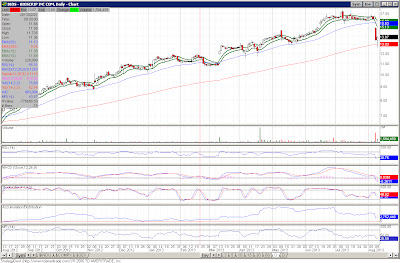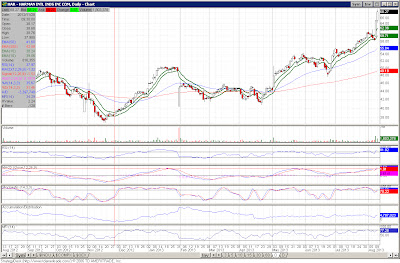How Bezos will navigate the intersection of his management style versus the cultural differences at the Washington Post will highlight one of the most important qualities of disruptive innovation, namely how an organization is structured around business, operational, and cultural lines. For instance, think about the below article from the Harvard Business Review in regards to Bezos' management style. Not that it will be impossible for Bezos to innovate at the Washington Post, but he will most likely face an uphill battle considering the entrenched culture. The strategic path and choices made will be interesting to watch, not only in regards to the Washington Post but also in relation to how you should think about other companies integrate acquisitions and cultures.
Transformationally speaking, technological innovation is easy.
Culture change is not. Jeff Bezos knows this. If he wants to kindle his
newly-acquired Washington Post into Amazon Prime, he's free to do so. Technically enhancing the Post
will be a digital snap. Getting his paper — pun intended — to adopt,
adapt to or embrace an authentically customer-centric Bezosian vision,
however, will prove very, very hard.
The reasons for that resistance will have little to do with money but almost everything to do with the Post's proud, defiantly elitist and self-righteously professional self-image (a self-image equally ensconced in papers like The New York Times, The Boston Globe and Los Angeles Times, as well). That prideful culture is simultaneously responsible for the paper's greatest successes and most humiliating journalistic and commercial failures.
As a former reporter and columnist there, I genuinely admired and respected both my newsroom colleagues and our business counterparts. But the Post's brave new entrepreneurial owner undeniably embodies two values that were never part of the paper's cultural norms: (1) being data-driven and (2) providing measurably superior customer experience. That's simply not what newspapers do.
Almost everything that makes Jeff Bezos Jeff Bezos as an innovator is organizationally alien to what made The Washington Post The Washington Post as a newspaper. At the Post, reporters report, editors edit and ad sales people sell ads. Journalists tell stories and report news; they don't do UX. Newspapers are indeed in information and digital content businesses. But their decision-making is typically far less data-driven than the big box retailers whose advertising they're so desperate to get. As a rule, newspapers know less about their readers and advertisers than an Amazon, Google or Facebook does.
These institutions built their brands not by focusing on customer experience or using strategic analytics but by successfully defining the most important and newsworthy stories in their communities and beyond. Those days are officially gone. So are the business models that made them profitable. The competition has both bigger and better data while offering much better customer experiences. There's little these papers do that deserves to command a marketplace premium from customers.
Serious innovators look to Amazon, not The Washington Post, The New York Times, The Wall Street Journal or The Boston Globe for innovation inspiration. Being a better newspaper or having better reporters, editors, web masters and ad salespeople doesn't solve the problem. They're no longer fit for purpose. The whole is worth less than the sum of its diminishing parts.
So when Bezos writes, "We will need to invent, which means we will need to experiment. Our touchstone will be readers, understanding what they care about — government, local leaders, restaurant openings, scout troops, businesses, charities, governors, sports — and working backwards from there. I'm excited and optimistic about the opportunity for invention," he effectively acknowledges that the status quo he purchased is unsustainable and — more importantly — existing cultural norms cannot endure. Can elite — and elitist — journalists who professionally prefer to tell readers what's important reinvent themselves as interlocutors and explainers who can digitally engage to inform? Will editors who've learned how to motivate prima donna reporters be able to turn themselves into "crowdsourcing shepherds" capable of tapping the collective intelligence of reader communities into stories everyone tweets, links to and talks about?
Can people who went into publishing precisely because there was no math learn how to take statistical advantage of petabytes of data to better customize, personalize or illuminate a customer app or experience? Will an industry that has institutionally treated customer feedback as an irritant — look at the online comments section of any major newspaper — finally have the wit and innovation to monetize their readers' best, brightest and most provocative comments?
The answers, as Bezos surely knows, have little to do with the Post's technical abilities to interoperate with Amazon Web Services and everything to do with profound cultural transformation. You can't lead at Amazon unless you're willing to be data-driven and relentlessly invested in improving customer experience. Will that Bezosian ethos be true for the Post in three or four years? Or will Amazon's founder be demonized and dismissed as someone who "just doesn't get" what elite journalism is supposed to mean?
These cultural challenges aren't unique to the Post; they're endemic to the industry. Nate Silver, arguably the most innovative data-driven journo-blogger in America, recently left The New York Times for ESPN. John Henry, the billionaire investor who brought Bill James and "Moneyball" insight to the Boston Red Sox — and winning the World Series in the process — just purchased The Boston Globe from The New York Times Company. Could a Bill James/Moneyball approach transform newsroom culture and best practice much the way it did for baseball? Of course. Then again, there's already a Bill James/Moneyball innovator in the daily news business; it's called Google. Bezos knows about competing with them, too.
For now, Bezos is keeping the current leadership of the Post in place. The Washington Post I know was a "lead by example" place. What data-driven decision and customer experience leadership examples will they now set? What do they want to learn from their new owner to help transform their old newspaper? How will they reinvent themselves?
Because if the paper's leaders don't embrace and enact Bezos' values, you can be sure the newsroom won't either. That would truly be the end.
The reasons for that resistance will have little to do with money but almost everything to do with the Post's proud, defiantly elitist and self-righteously professional self-image (a self-image equally ensconced in papers like The New York Times, The Boston Globe and Los Angeles Times, as well). That prideful culture is simultaneously responsible for the paper's greatest successes and most humiliating journalistic and commercial failures.
As a former reporter and columnist there, I genuinely admired and respected both my newsroom colleagues and our business counterparts. But the Post's brave new entrepreneurial owner undeniably embodies two values that were never part of the paper's cultural norms: (1) being data-driven and (2) providing measurably superior customer experience. That's simply not what newspapers do.
Almost everything that makes Jeff Bezos Jeff Bezos as an innovator is organizationally alien to what made The Washington Post The Washington Post as a newspaper. At the Post, reporters report, editors edit and ad sales people sell ads. Journalists tell stories and report news; they don't do UX. Newspapers are indeed in information and digital content businesses. But their decision-making is typically far less data-driven than the big box retailers whose advertising they're so desperate to get. As a rule, newspapers know less about their readers and advertisers than an Amazon, Google or Facebook does.
These institutions built their brands not by focusing on customer experience or using strategic analytics but by successfully defining the most important and newsworthy stories in their communities and beyond. Those days are officially gone. So are the business models that made them profitable. The competition has both bigger and better data while offering much better customer experiences. There's little these papers do that deserves to command a marketplace premium from customers.
Serious innovators look to Amazon, not The Washington Post, The New York Times, The Wall Street Journal or The Boston Globe for innovation inspiration. Being a better newspaper or having better reporters, editors, web masters and ad salespeople doesn't solve the problem. They're no longer fit for purpose. The whole is worth less than the sum of its diminishing parts.
So when Bezos writes, "We will need to invent, which means we will need to experiment. Our touchstone will be readers, understanding what they care about — government, local leaders, restaurant openings, scout troops, businesses, charities, governors, sports — and working backwards from there. I'm excited and optimistic about the opportunity for invention," he effectively acknowledges that the status quo he purchased is unsustainable and — more importantly — existing cultural norms cannot endure. Can elite — and elitist — journalists who professionally prefer to tell readers what's important reinvent themselves as interlocutors and explainers who can digitally engage to inform? Will editors who've learned how to motivate prima donna reporters be able to turn themselves into "crowdsourcing shepherds" capable of tapping the collective intelligence of reader communities into stories everyone tweets, links to and talks about?
Can people who went into publishing precisely because there was no math learn how to take statistical advantage of petabytes of data to better customize, personalize or illuminate a customer app or experience? Will an industry that has institutionally treated customer feedback as an irritant — look at the online comments section of any major newspaper — finally have the wit and innovation to monetize their readers' best, brightest and most provocative comments?
The answers, as Bezos surely knows, have little to do with the Post's technical abilities to interoperate with Amazon Web Services and everything to do with profound cultural transformation. You can't lead at Amazon unless you're willing to be data-driven and relentlessly invested in improving customer experience. Will that Bezosian ethos be true for the Post in three or four years? Or will Amazon's founder be demonized and dismissed as someone who "just doesn't get" what elite journalism is supposed to mean?
These cultural challenges aren't unique to the Post; they're endemic to the industry. Nate Silver, arguably the most innovative data-driven journo-blogger in America, recently left The New York Times for ESPN. John Henry, the billionaire investor who brought Bill James and "Moneyball" insight to the Boston Red Sox — and winning the World Series in the process — just purchased The Boston Globe from The New York Times Company. Could a Bill James/Moneyball approach transform newsroom culture and best practice much the way it did for baseball? Of course. Then again, there's already a Bill James/Moneyball innovator in the daily news business; it's called Google. Bezos knows about competing with them, too.
For now, Bezos is keeping the current leadership of the Post in place. The Washington Post I know was a "lead by example" place. What data-driven decision and customer experience leadership examples will they now set? What do they want to learn from their new owner to help transform their old newspaper? How will they reinvent themselves?
Because if the paper's leaders don't embrace and enact Bezos' values, you can be sure the newsroom won't either. That would truly be the end.




































